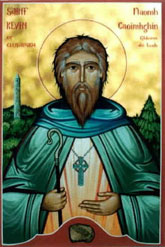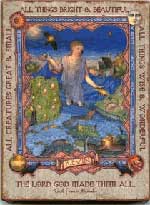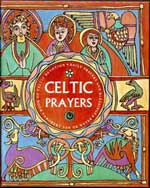| |

Traditions, folklore, history and more. If it's Irish, it's here. Or will be!
"People will not look forward to posterity who never look backward to their ancestors."
-Edmund Burke




Quotes
Library: Books, Movies, Music
Prints & Photos
Poetry
Jokes


Shops Ireland
Bunús na Gaeilge
(Basic Irish)
Circle of Prayer
Blessings
Did You Know?
Himself/Herself
Write to Us
Readers Write..
Links/Link to Us
Advertise with us
Awards & Testimonials
Submissions Guide


|
|
|
St. Kevin - founder of Glendalough
 by Bridget Haggerty by Bridget Haggerty
As with St. Columba, Kevin's family were of the nobility - he was the son of Coemlog and Coemell of Leinster. At his birth in 498 at the Fort of the White Fountain, he was given the name of Coemgen, which meant "beautiful shining birth. He also came into the world without the usual pains of labour.
St. Kevin’s birth and early years figure prominently in traditional legends. An angel is said to have appeared as Kevin was about to be baptised and told his parents that the child should be called Kevin. The priest - Father ronan of Roscrea - who performed the ceremony said, “This was surely an angel of the Lord and as he named the child so shall he be called”. So Kevin received the name which in Latin means pulcher-genitus or the fair-begotten. He is the first person in history to carry the name and it is also said that he was the fulfillment of the prophecy of St. Patrick - that he was the one to come who would evangelize the region of Ireland just south of Dublin.
From the age of seven, he was educated by St. Petroc of Cornwall and he lived with monks until he was 12. Called to the monastic life, he studied for the priesthood and was tutored by St. Eonaghan. His earliest tutor was St. Petroc of Cornwall, who had come to Leinster about 492, and devoted himself with considerable ardour to the study of the Sacred Scriptures, in which his pupil also became proficient.
Kevin next studied under his uncle, St. Eugenius, afterwards Bishop of Ardstraw, who at that time lived at Kilnamanagh in Wicklow, where he taught his pupils all the sacred learning which he had acquired in the famous British monastery of Rosnat.
Kevin was ordained by Bishop Lugidus and following his ordination, he lived as a hermit in a cave at Glendalough, a Bronze Age tomb now known as St. Kevin's Bed, to which he was reportedly led by an angel. He went barefoot, wore skins, ate the nettles and herbs that came to hand, and spent his time in prayer.
It was a lonely life; still we are told that "the branches and leaves of the trees sometimes sang sweet songs to him, and heavenly music alleviated the severity of his life." Perhaps it was in this cave, too, that Kevin learned to play that harp of his that would long remain a treasured relic. When he later wrote his monastic rule, it was composed in verse. Possibly, he even set it to music on the harp.
Kevin was blessed with good looks, and unconsciously he won the affections of a beautiful maiden named Kathleen who is said to have had “eyes of most unholy blue.” Ignoring the fact that he was bound by holy vows, the bold Kathleen followed Kevin into the woods; when he felt her presence, he threw himself into a bed of nettles; he then gathered a handful of the burning weeds and scourged the maiden. One biographer cites Kevin as saying, "The fire without extinguished the fire within.”
In this writer’s opinion, it seems out of character for a person as gentle as Kevin to have acted so violently. But the scourging is nothing compared to how the poets Gerald Griffin and Thomas Moore dramatised the meeting. The two works , colourful though they are, appear to be totally imaginative and to have little bearing on the incident. Would Kevin be likely to “Hurl the maiden from the rock into the black lake shrieking” as Griffin’s poem suggests? Or would he have “Hurled her from the beetling rock” into the lake, as indicated in Moore’s verse? Very unlikely. Especially when one considers that Kathleen sought Kevin’s forgiveness and is said to have become a very holy woman, noted for her great sanctity.
As with many hermits, St. Kevin had a special love for birds and animals, which is illustrated in numerous stories. The “Acta Sanctorum” which is based on an ancient manuscript contains a number of legends. The author of a commentary on this manuscript, Fr. Francis Baert, S.J., explains, “that although many of the legends given to this work are of doubtful veracity; it was decided to let them stand in favour of the antiquity of the document which is placed as having being written during or before the 12th century”.
The legends include one about a blackbird laying an egg in Kevin’s hand when his arms were outstretched in prayer. The saint remained in this position until the baby bird hatched. (Seamus Heaney writes a poem about this event and explores the relationship between meaning and myth).
Long before his time in the cave, strange miracles were part and parcel of Kevin’s life. When an infant, a mysterious white cow came to his parent’s house every morning and evening and supplied the milk for the baby. When Kevin was old enough he was put to tending sheep. One day some men came to him and begged him to give them some sheep. He was touched by their poverty and gave them four sheep. When evening came, however, and Kevin’s sheep were counted. the correct number were still there.
On a day in autumn,, Kevin was working in the kitchen. Meals were being prepared for harvesters who were busy gathering crops in the fields when a number of pilgrims called and asked for food. Kevin, filled with compassion, gave them the harvesters’ dinner. He was rebuked by his superiors for his action. He then told the attendants to fill all the ale jars with water and gather together all the bare meat bones. Then he prayed alone and, it is said, the water turned to ale and the bones were covered with meat again.
In another story, a boar was being chased by a group of hunters with their dogs. It ran to where Kevin sat praying under a tree, and cowered beside him for protection. When the dogs saw the saint in prayer, they laid on their stomachs, and would not approach the boar. When the hunters decided they would ignore the man and kill the boar, a flock of birds settled in the tree above the praying saint. The hunters took this as a sign, and left man and beast alone.
Perhaps one of the most interesting legends is about a pet goose which belonged to King O'Toole of Glendalough. Both the king and the goose were getting on in years and as time passed, the goose became weak and unable to fly. Hearing of Kevin's sanctity and power, the king sent for him, and asked that he make the beloved goose young. Kevin asked for a payment of whatever land the goose would fly over. As the goose could no longer take flight, O'Toole agreed. When Kevin touched the bird, it grew young, and flew over the entire valley that was used to found the monastery of Glendalough.
So how did the he great monastery come about? History tells us that after seven years in the cave, a farmer named Dima discovered the skin-clad hermit in his hideout. Kevin yielded to Dima's persuasion to go to the place in the valley that came to be known as Disert Coemgen. Here disciples soon gathered around Kevin and they talked him into being their spiritual leader. For a while, as the story, goes, a friendly otter would daily bring a salmon to feed Kevin and his monks. Then, one day the thought entered the head of farmer Dima's son that he could make a fine pair of gloves out of the otter's pelt. The otter seems to have sensed peril, for after that day he disappeared and the monks had to seek provisions elsewhere.
Perhaps it was lack of available food that persuaded Kevin to move farther up the glen, at the junction of two sparkling streams. Here, he established his permanent monastery. He is also reported to have made a pilgrimage to Rome around this time to bring back the blessing of the Pope to his community.
It was at the new site that Kevin and his monks started to erect the first rough churches, cells and round tower that would make the settlement a center of pilgrimage, and its very ruins a memorable sight even up to the present day.
In his time, the charismatic and kind St. Kevin attracted numerous visitors to Glendalough and many stories are still told of his legendary way with animals. One tale tells us that King Colman of the Faelain, having lost his earlier sons by deaths that he blamed on evil spirits, entrusted his next infant son, Faelan, to the care of the saintly abbot. Now, the monastery had no cows to provide milk for the child. But Kevin, encountering a doe, commanded her to nurse the little prince along with her fawn. The doe obeyed. When that source of nourishment ceased, somehow St. Kevin ordered a she-wolf to take over the task. The wolf also complied. As a result, Colman's son grew up strong and healthy.
Other boys were likewise sent to the monks to be educated. On a certain day one of them asked for an apple. The monastery had no more apple trees than it had cows, but St. Kevin blessed a clump of willow trees and the willows began to bear apples. Four centuries later these miraculous trees were still producing "St. Kevin's apples," and they were in demand all over Ireland.
Kevin also planted a yew tree at the door of what would be, from the twelfth to the fifteenth centuries, the cathedral church of Glendalough. This yew was revered as a special heritage of the saint until 1835, when a neighboring landowner chopped it down for use in making furniture. Devotees of St. Kevin hastened to collect every last chip of the wood as relics of the venerable founder.
Still another story is told about the actual construction of the cathedral. Folklorists tell us that when the cathedral was being built the labourers and masons agreed to work as long a day as possible and to “rise with the lark and lie with the lamb”. These long hours soon had the men exhausted and when Kevin investigated he found that the local larks started their day extremely early. He prayed for an answer to the problem and from that day, according to tradition, the skylark ceased singing in Glendalough.
As Word of Kevin’s holiness spread, Glendalough became the “parent” of several other monastic foundations. After visiting Sts. Columba, Comgall, and Cannich at Usneach in Westmeath, Kevin proceeded to Clonmacnoise, where St. Cieran had died three days before, in 544. Having firmly established his community, he retired into solitude for four years, and only returned to Glendalough at the earnest entreaty of his monks. He belonged to the second order of Irish saints and probably was never a bishop. So numerous were his followers that Glendalough became a veritable city in the desert. Glendalough was later an episcopal see, but is now incorporated with Dublin. St. Kevin's house and St. Kevin's Bed of rock are still to be seen: and the Seven Churches of Glendalough have for centuries been visited by pilgrims from all over the world.
Widely noted though he was, St. Kevin was always a hermit and a pilgrim at heart, and disliked being tied down. Even in his old age he had a yearning to make just one more pilgrimage. However, when he mentioned his desire to a wise old man, the aged one replied, "Birds do not hatch their eggs when they are on the wing." Kevin took that as a sign from God that he should stay where he was.
St. Kevin died in 618 of natural causes and he was canonized in 1903. His feast day is celebrated on July 3rd in both Orthodox and Western calendars. In Ireland it is celebrated on June 3rd. The Feast of St. Kevin is also sometimes known as Pattern Day in Glendalough or simply "Pattern" which is the general term for a designated date honouring the local patron saint. After the British all but destroyed the celebrated community in 1398, the Irish and others still came and prayed in the name of St. Kevin. After the Dissolution of the Monastaries in 1539, when the community was closed down as an official church site, the ever-faithful followers of St. Kevin came every June 3, the anniversary of his death, in memory of the great teacher and holy man. In fact, the Feast of St. Kevin became a riotous event by the 18th and 19th centuries - the peak of the St. Kevin's Day frenzy. The church, which frowned on such joyous revelry - at least officially - banned the festival in the 1890s.
As might be expected, the “St. Francis of Ireland” is the patron saint of blackbirds.He is also honoured as such in Dublin and Glendalough.
Resources:
Content:
O'Hanlon's Lives of Irish Saints (Dublin, 1875), VI, 28 sqq.; Healy's Ireland's Ancient Schools and Scholars (Dublin, 1890); LLanigan, Ecclesiastical Hist. of Ireland (Dublin, 1829), II; Olden, in Dict. Nat. Biog., s.v.
New Advent
St Kevin's Young Adult Community
Essay by Stuart Astill
Essay by Fr. Robert F. McNamara
Saint Alive
Glendalough.connect
Image:
St. Kevin Icon reprinted by kind permission of the artist, Nick Papas
|
|
Fri, Sep 27, 2024
 The Galway Hooker The Galway Hooker
This unique vessel, with its distinctive curved lines and bright red sails, originated in the village of Claddagh. During the 19th century, hookers supported a significant fishing industry and also carried goods, livestock and fuel. Seán Rainey is remembered for building the last of the original boats, the Truelight, for Martin Oliver who was to become the last king of the Claddagh; as king, he was entitled to white sails on his boat. Since the mid seventies, many of the old sailing craft which were on the verge of extinction have been lovingly restored and new ones have been built. During the summer months they can be seen at festivals such a Cruinniú na mBád - the Gathering of the Boats - in Kinvara.
Click for More Culture Corner.

St. Kevin Anachron
St. Kevin's Feast Day is June 3rd. He is the patron saint of Dublin and Glendalough. This anachron shows Kevin standing in the lake, holding an egg that a black bird has left in his hand. An otter offers him salmon and apples grow on a willow tree. Other animals featured in legends of Kevin are also depicted.
Click here for St. Kevin.

Celtic Prayers
by Robert Van de Wyer
Illustrated with designs from the Book of Kells and other Celtic and Irish designs, the prayers reflect a profound view of nature and life. I strongly recommend this to pastors or lay people with any interest in Celtic culture. Edited from an Amazon review
Click here for Celtic Prayers.
|
A fascinating, very cleverly written account that's part fiction and part fact. But don't be misled by the "fiction" part. The stories that Mr. Moorhouse tells are all based on thoroughly researched historical evidence. Bridget Haggerty
"Moorhouse writes with eloquence and a quiet humor calculated to charm even the blackest of heathens." Atlantic Monthly
"The chilling facts of the monks' penitent lives are real enough to send a shiver down an Irish Catholic's spine." New York Times Book Review
Click here for Sun Dancing.
|
|
|
|
|




 The Galway Hooker
The Galway Hooker